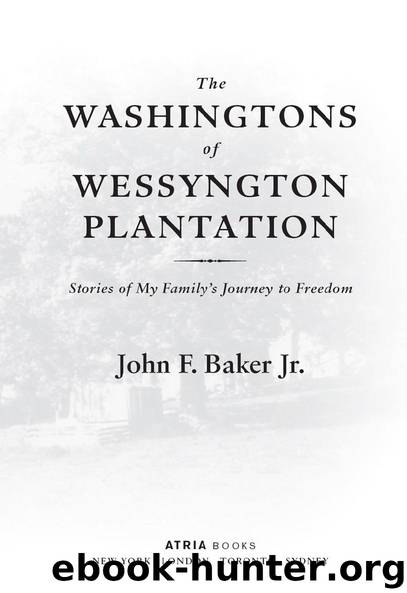The Washingtons of Wessyngton Plantation by John F. Jr. Baker

Author:John F. Jr. Baker
Language: eng
Format: epub
Publisher: Atria
Published: 2009-02-03T00:00:00+00:00
In December 1863 George requested and received permission from a Union Major R. S. Granger to send a portion of the women and children inside Union lines in Nashville.
In January 1864 General Rousseau issued Washington permission for additional firearms: four shotguns and four revolving pistols. In February another seizure of slaves occurred but in that case, former Wessyngton slaves—Little Sam, Leroy Lewis, Mario, and Simpson—probably met four Union soldiers in Nashville and brought them back to the plantation to get their families in case there was any trouble. The federal soldiers and the former Wessyngton slaves rode in a wagon to the Dortch Place, where they picked up Sarah Jane, Fanny, Isabella and her child, Allen Holman, Martha Lewis, Austin B., Harrison, Little Joe, Meredith, Big John White, and Tom White. The soldiers had guns, and the slaves had pistols. They took their bedding in a wagon and took Sampson’s wheel mule, Joe, with them. They also took their dinner from the kitchen and a shoulder of meat. They announced that everyone who wished to was free to go. Jane feared that Simpson would bring them to the Home Place. Another Wessyngton slave Bob Price, who was at a shop in Turnersville, spotted the group as they went up the Nashville road. 40
Less than a week later, when George was in Nashville, he went to General Rousseau’s headquarters. The general ordered his soldiers to send the “17 Runaway Negroes…back home.” With all the comings and goings, we do not know if they all returned to the Dortch Place. 41
In August 1864 George obtained protection papers from the provost marshall’s office, granting protection for his farm, timber, forage, stock, buildings, provisions, wagons, horses, and all other personal property. The protection papers also prohibited the impressments of his slaves, taking them from the plantation for army use. At the same time George obtained a permit to own a gun and ammunition to protect himself and his family. Major General Rosencrans signed the orders and charged all officers and soldiers in the United States service to respect and, if necessary, to enforce the protection. (In one of those ironic twists of history, Rosen crans’s headquarters in Nashville was located at the home of Jane Smith Washington’s cousin Hugh Kirkman. The mansion had cost over $125,000 to build and furnish in the 1830s, but the Kirkmans never reoccupied the house after the war; they considered it tainted by the presence of the Union Army).
The federal protection documents proved as worthless as the paper they were written on. Union soldiers made a number of visits to the plantation, taking provisions and slaves as they pleased and paid little to no attention to the orders. On August 8, 1864, a lieutenant from the Union Army came to Wessyngton to impress more slaves. Jane informed him she had only three or four left on the place and had General Rousseau’s protection papers for them. The elderly Britain mounted one of the soldiers’ horses and led them directly to the Fiser Field, where Granville thought he had safely hidden their horses.
Download
This site does not store any files on its server. We only index and link to content provided by other sites. Please contact the content providers to delete copyright contents if any and email us, we'll remove relevant links or contents immediately.
| Africa | Asia |
| Canadian | Europe |
| Holocaust | Latin America |
| Middle East | United States |
Fanny Burney by Claire Harman(26526)
Empire of the Sikhs by Patwant Singh(22974)
Out of India by Michael Foss(16791)
Leonardo da Vinci by Walter Isaacson(13181)
Small Great Things by Jodi Picoult(7019)
The Six Wives Of Henry VIII (WOMEN IN HISTORY) by Fraser Antonia(5394)
The Wind in My Hair by Masih Alinejad(5034)
A Higher Loyalty: Truth, Lies, and Leadership by James Comey(4843)
The Lonely City by Olivia Laing(4750)
The Crown by Robert Lacey(4723)
Millionaire: The Philanderer, Gambler, and Duelist Who Invented Modern Finance by Janet Gleeson(4375)
The Iron Duke by The Iron Duke(4291)
Papillon (English) by Henri Charrière(4195)
Sticky Fingers by Joe Hagan(4101)
Joan of Arc by Mary Gordon(4013)
Alive: The Story of the Andes Survivors by Piers Paul Read(3968)
Stalin by Stephen Kotkin(3875)
Aleister Crowley: The Biography by Tobias Churton(3586)
Ants Among Elephants by Sujatha Gidla(3417)
